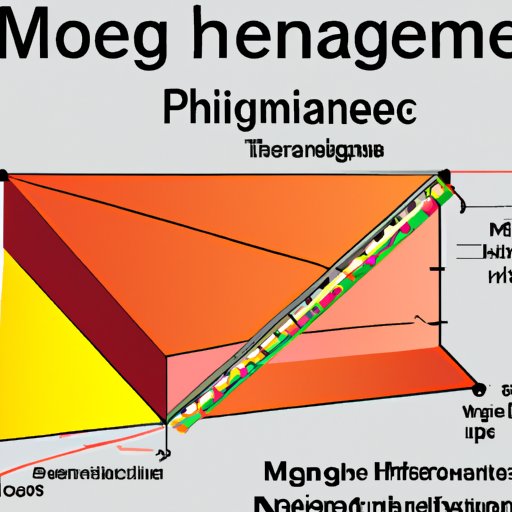
I. Introduction
Vector magnitude is a crucial concept in various fields such as physics, engineering, and computer graphics, and understanding how to find it is essential for problem-solving. In this guide, we will explain vector magnitude in a beginner-friendly language and provide step-by-step guidance on how to calculate it.
II. Understanding Vector Magnitude: A Beginner’s Guide
Vector magnitude is the scalar representation of the length of a vector. It is indicated by the absolute value of the vector and represents the distance from the origin to the point represented by the vector. Vector magnitude is essential because it provides information about the strength or intensity of a vector and is a necessary component for vector addition and subtraction. The notation for vector magnitude is denoted by a pair of vertical bars around the vector. In three-dimensional space, the magnitude can be expressed as
|a| = √(ax2 + ay2 + az2)
III. The What, the How, and the Why of Vector Magnitude
Vector quantities are those that have both magnitude and direction, while scalars are those that have only magnitude. Magnitude is the most fundamental property of a vector and is essential in many fields. In physics, magnitude is used to represent physical quantities such as force, velocity, and acceleration. Similarly, in engineering, magnitude is required for design and analysis, and in computer graphics, it represents a pixel’s brightness. Finding the magnitude of a vector is especially crucial for vector addition and visualization because it allows for useful interpretations of vector quantities.
To obtain the magnitude of a vector, we use some measured or calculated components of that vector. The steps involved in finding the magnitude of a vector are explained in more detail below.
IV. A Step-by-Step Guide for Finding the Magnitude of a Vector
The following is a detailed procedure for calculating the magnitude of a vector:
- Find the components of the vector. For example, ax, ay, and az (if the vector exists in three-dimensional space).
- Square each component and add them together.
- Take the square root of the sum to obtain the magnitude of the vector.
We can represent this formula as |a| = √(ax2 + ay2 + az2). Consider the vector (2,3,1), the magnitude of the vector would be:
|a| = √(22 + 32 + 12)
= √(14)
≈ 3.74
V. How to Derive the Equation for Vector Magnitude
The Pythagorean theorem, which states that the sum of the squares of the legs of a right triangle equals the square of the hypotenuse, can be used to derive the equation for vector magnitude. Consider the right-angled triangle depicted below:

Where a and b are the legs, and c is the hypotenuse. The length of the hypotenuse is determined from the two legs by using the Pythagorean theorem:
c2 = a2 + b2
If we consider the hypotenuse of this triangle as the vector, then the square of its magnitude would be equal to the sum of squares of its components:
|a|2 = ax2 + ay2
To obtain the magnitude |a|, we take the square root of both sides of this equation:
|a| = √(ax2 + ay2)
The same principle can be extended to three-dimensional vectors.
VI. Quick and Easy Methods for Calculating Vector Magnitude
If you are working with a vector in two dimensions, you can use the distance formula, which is a simplified version of the magnitude formula. The distance formula is:
|a| = √((ax2 – ax1)2 + (ay2 – ay1)2)
This formula can be quite useful when working with vectors on the coordinate plane.
Another trick to simplify calculation is to use the dot product of two identical vectors to find the square of the magnitude. The dot product of a vector with itself is:
a⋅a = |a|2
This trick may help to avoid squaring the components of the vector separately, but be mindful of using the correct operation, which is multiplication and not addition. Similarly, you can use the dot product of two vectors to find the angle between them.
While these tricks can make calculations easier, be wary of their context, and never blindly apply them. They’re only effective in particular instances, while other situations may necessitate the full previous procedure for finding vector magnitude.
VII. Exploring the Concept of Vector Magnitude and Its Applications
Vector magnitude has many valuable real-world applications, whether computing forces, velocities, accelerations, or distances, to mention a few. For instance, we can calculate the distance between two points in two or three-dimensional space, with one point given by vector a, and the other by vector b, as:
d = |a – b|
Where the distance d is the magnitude of their difference.
In physics, vectors are fundamental quantities, and hence their magnitudes are significant. For example, force is a vector quantity and is frequently measured in physical experiments. By calculating the magnitude of force, we can determine the amount of rotation or displacement required for a particular object to experience under the application of the force.
Similarly, distance and displacement in mechanics are vector quantities, and their magnitudes are determined through vector subtraction as mentioned earlier. The result is always a scalar as it is a single quantity with only magnitude and no direction.
Other applications of vector magnitude include the graphical representation of images in computer science. Often, the magnitudes of pixel values are used to represent brightness, helping in the editing and analysis of digital images.
VIII. Conclusion
Vector magnitude is an essential concept in various fields, including physics, engineering, and computer graphics. The magnitude of a vector provides information about the vector’s strength, intensity, and distance, and is essential for vector addition and subtraction. In this article, we discussed how to calculate the magnitude of a vector using the Pythagorean theorem and provided helpful tips for simplifying the calculation. Remember always to be mindful of the components you’re dealing with and their context.





